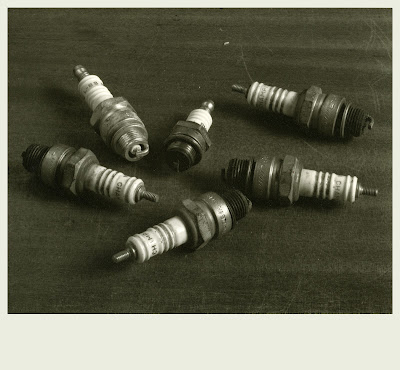Anyway, these old spark plugs were lying around from the good ol' days so I set them out and photographed them using the Sinar 4x5 with an old 210mm Rodenstock Symmar-S f/5.6 lens. 210mm in 4x5 world is close to 60mm in 35mm terms:
 |
| Sparking Plugs, 2020. FP4+ Delta, RO9 and Foma 133 paper in WT-10 developer |
This was pretty about 1:2 on the negative, which is about as close as I can get with the setup I have (about 300mm bellows extension). Any more and I'd need a longer rail - the closer you want to get to your subject the farther the film plane has to be from the taking lens - for 1:1 you need double the focal length of the lens, so for a 210mm lens that's 420mm of extension. Obviously with a shorter focal length lens it's easier to get closer, so if I ever come across an affordable 150mm lens or similar I might pull the trigger, but it's a lot cheaper to get a rail extension, which I think is my next move. There are dedicated 4x5 Macro lenses but amazingly these still command stratospheric prices, which is hard to fathom when anyone doing commercial product photography these days is using digital.
On this shot, in order to get everything in focus I was using a lot of tilt on the front standard, so the plane of focus is close to the tabletop. Even then, at f/22 I think things are a little tight - I could have done with a bit more tilt or stopped down to f/32. It's a completely boring shot, I know, but I'm enjoying messing about with the Sinar while learning about the idiosyncrasies of large format photography.
My last few cars have needed plugs every 100,000 miles, which is still astonishing to me. I remember when I borrowed Dad's spare car for my entire senior year in engineering school. It was a Renault, I think over there you might have known it as the 9 but over here it was the Alliance. Tiny little 4 cylinder engine, needed plugs every 30,000 miles. To save money I had a mechanic buddy do it. The first three plugs went out and new ones in easily enough, but the fourth was in a very inconvenient location and it took my buddy a half hour to get it out and the new one in. The one he got out was charred black -- clearly, nobody had ever managed to replace it before. The car ran a whole lot better after that.
ReplyDeleteWhen I was young it seemed that cars needed regular (frequent) attention. Modern ones less so, but when they repaired it’s usually big bucks.
DeleteI recall a taxi driver in Washington DC telling me his cars did over 300,000 miles - he changed the oil every 3000 miles regular as clockwork. That’s astonishing mileage.
Thanks for the explanation of how you got everything in focus. I know about tilt, but I didn't know that much about focusing with large format.
ReplyDeleteMy father and grandfather used to do vehicle maintenance themselves and even sone repairs. I remember when my father bought a new car one year and opened the bonnet when he got home. His face fell and he said, "Oh. I guess I'll be bringing this one to the shop when something goes wrong." The engine was almost unrecognisable. I remember some people used to buy Korean cars at that time because they weren't that advanced and you could do things with them yourself.
The Sinar makes things very easy - it has scales to help with tilt and depth of field, all based around focussing the various elements of the scene. You have to have good light to be able to do that, though. What I need to do is rig up a decent spotlight on the table just to aid focussing - then switch it off before taking the shot. Focussing on the ground glass is pretty easy, but (and it’s a big but) you have to be looking straight at it. Depending on the angle of the camera I don’t always find it so easy, with my fused spine and neck. Most times I compromise - do what I can, factor in a bit of latitude and hope for the best.
Delete